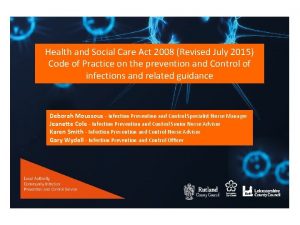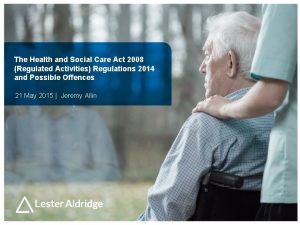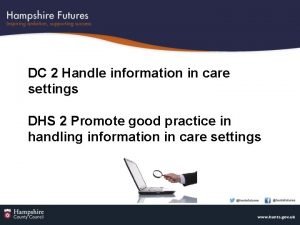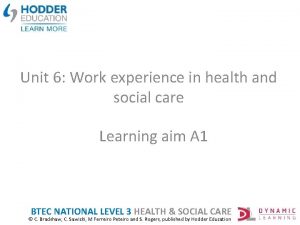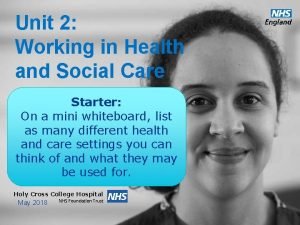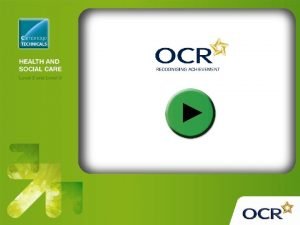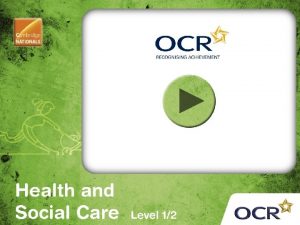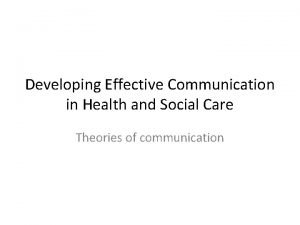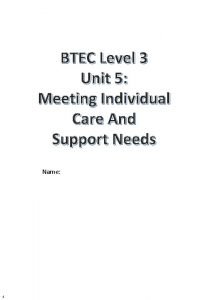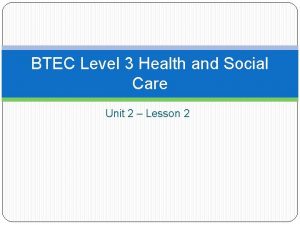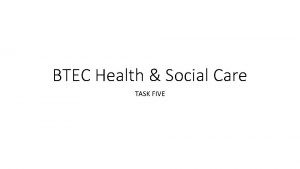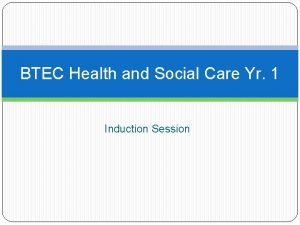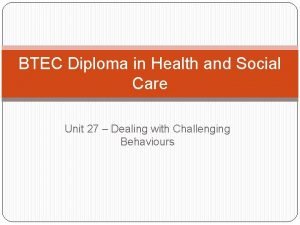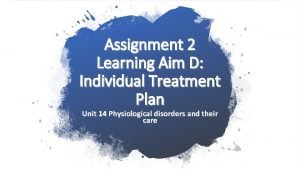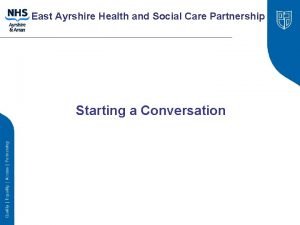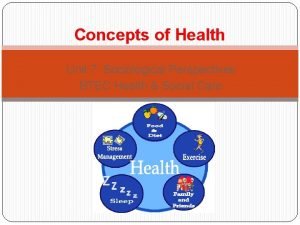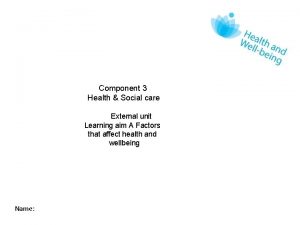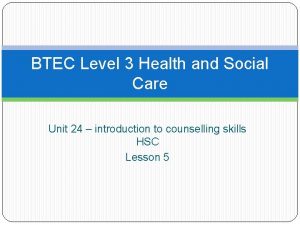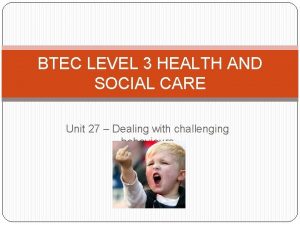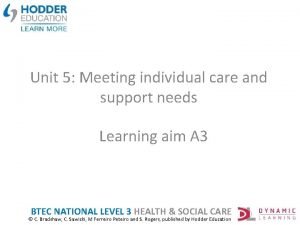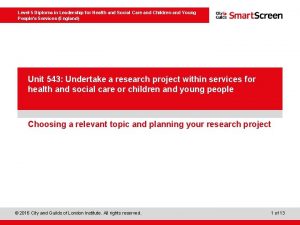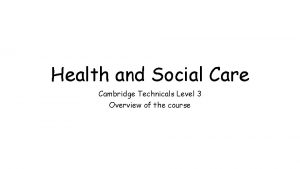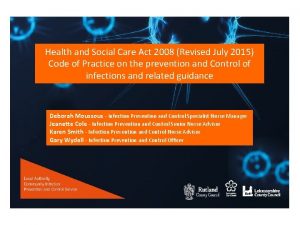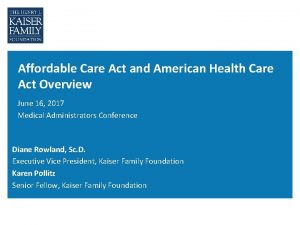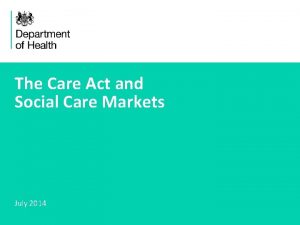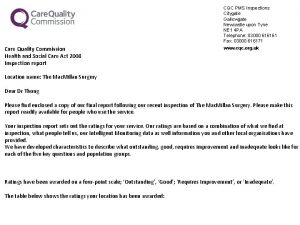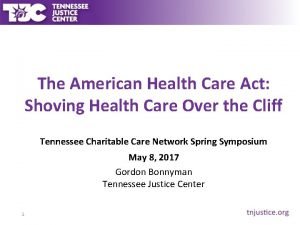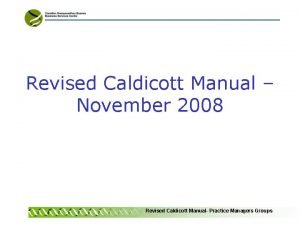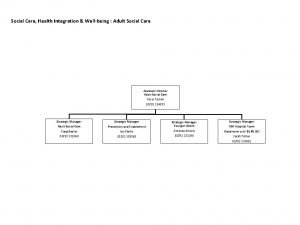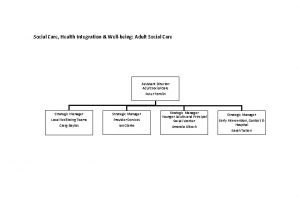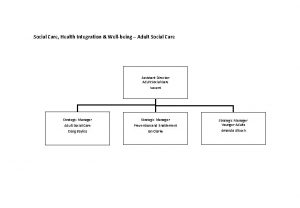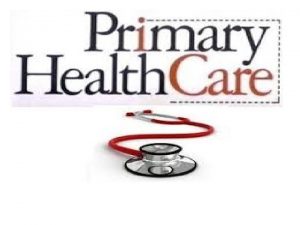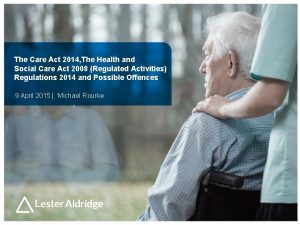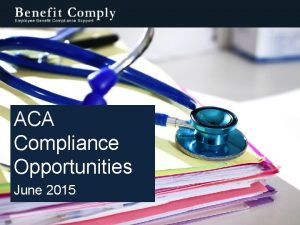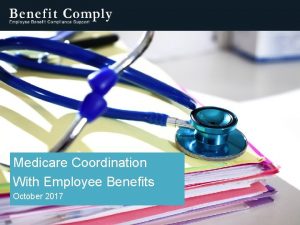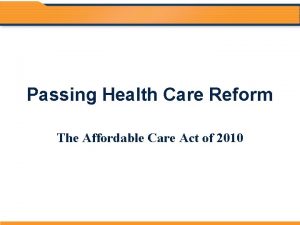Health and Social Care Act 2008 Revised July



































- Slides: 35

Health and Social Care Act 2008 (Revised July 2015) Code of Practice on the prevention and Control of infections and related guidance Deborah Moussous - Infection Prevention and Control Specialist Nurse Manager Jeanette Cole - Infection Prevention and Control Senior Nurse Advisor Karen Smith - Infection Prevention and Control Nurse Advisor Gary Wydell - Infection Prevention and Control Officer

The Health and Social Care Act 2008 Code of Practice on the prevention and Control of infections and related guidance The Health and Social Care Act 2008. Revised July 2015

What do the Regulations say? Registered providers are required to provide assurance that the care people receive meets the fundamental standards of quality and safety as set out in the registration requirements (Health and Social Care Act 2008 (Regulated Activities) Regulations 2014 (Part 3), 12 (2) (h)). The registered provider must provide assurance that systems are in place to prevent and control all risks relating to transmissible infections. The Regulations state that ‘When assessing risk, providers should consider the link between infection prevention and control, antimicrobial stewardship, how medicines are managed and cleanliness’.

Code of Practice – The 10 criteria 1. Systems to manage and monitor the prevention and control of infection 2. Provide and maintain a clean and appropriate environment. 3. Ensure appropriate antimicrobial use to optimise patient outcomes and to reduce the risk of adverse events and antimicrobial resistance 4. Provide suitable accurate information on infections to service users, their visitors and any person concerned with providing further support or nursing/ medical care in a timely fashion

Code of Practice – The 10 criteria 5. Ensure prompt identification of people who have or are at risk of developing an infection so that they receive timely and appropriate treatment to reduce the risk of transmitting infection to other people 6. Systems to ensure that all care workers (including contractors and volunteers) are aware of and discharge their responsibilities in the process of preventing and controlling infection 7. Provide or secure adequate isolation facilities 8. Secure adequate access to laboratory support as appropriate 9. Have and adhere to policies, designed for the individual’s care and provider organisations

Code of Practice 10 criteria 10. Have a system in place to manage the occupational health needs and obligations of staff in relation to infection When registering with the Care Quality Commission (CQC), the home has declared compliance with the 10 criterion of the Hygiene Code

Criterion 1 - Have in place systems to manage and monitor the prevention and control of infection. The home should have: • Mechanisms in place for preventing and controlling infection and the measures needed to reduce such risks. • Processes in place for reviewing IPC policies, procedures and guidance and if necessary develop new guidance • An audit programme in place to demonstrate staff adherence to policies and guidelines and compliance with clinical procedures • Processes in place detailing the initial and on-going training all staff involved (either directly or indirectly) with providing care will receive on the measures required to prevent the risk of infection

Criterion 1 (cont. ) - Have in place systems to manage and monitor the prevention and control of infection. The home should have in place an IPC Lead who produces an annual statement for each facility. This should be available to view on request and should provide a short review of any: – Outbreaks of infection in the home and any actions taken following the outbreak – Results of any audits undertaken, progress made against associated action plans – Details of risk assessments undertaken – Policies that have been reviewed, updated or developed – A record of any education and training received by staff

Criterion 2 – Provides and maintains a clean and appropriate environment in managed premises that facilitates the prevention and control of infections The home should have in place: • A designated lead for environmental cleaning and decontamination of equipment • Cleaning and decontamination policies/guidelines • The cleaning arrangements detail the standards of cleanliness required in each part of its premises and that a schedule of cleaning responsibility and frequency is available on request

The national specifications for cleanliness The Code of Practice requires that a cleaning policy should cover: • How to clean the different areas of the environment, fixtures, fittings and specialist equipment (e. g. a hoist) • What products and equipment to use when cleaning • What to do and what products to use if there is a spillage of blood or other bodily fluids • What training staff need to implement the policy

The national specifications for cleanliness Cleaning Plan: • Setting out clear policies and arrangements is best achieved through the production of a cleaning plan. • This will help providers meet the CQCs requirements in terms of documentary evidence around the provision of cleaning services and the legislative requirements of the code of practice. • There is no national standard for a cleaning plan and it is for each provider to produce their own. • The specifications set out a process through which the above requirement can be delivered using a toolkit which comprises of a table of annexes.

Annex 1 - Supporting Documentation • Details the risk assessment process undertaken • Details the areas and elements (items) which require cleaning • Sets out the required standards of cleanliness for each element • Sets out the frequency with which cleaning will be undertaken • Sets out the member of staff responsible for cleaning each item • Details the audit process to be followed • Provides advise on cleaning methods

Cleaning Services The arrangements for cleaning should include: • Clear definition of specific roles and responsibilities for cleaning • Clear, agreed and available cleaning routines • Sufficient resources dedicated to keeping the environment clean and fit for purpose • Consultation with ICTs or equivalent local expertise on cleaning protocols when internal or external contracts are being prepared • Details of how staff can request additional cleaning, both urgently and routinely

Properties of an Ideal Surface Disinfectant • Remain wet – It should keep surfaces wet long enough to meet the kill/contact times with a single application or meet the wet time recommended by evidence based guidelines (60 seconds) • Fast Acting – It should have a rapid kill/contact time listed on the label. Ideally this should be less than 5 minutes • Not affected by environmental factors – It should be able to deal with high levels of contamination and remain active in the presence of organic matter (e. g. blood, sputum, faeces). • Broad Spectrum – It should have a wide antimicrobial spectrum and include kill claims for all pathogens that are common causes of HCAIs and outbreak

Properties of an Ideal Surface Disinfectant • It should be able to deal with realistic levels of contamination, be compatible with soaps, detergents and other chemicals encountered. • Nontoxic – should not be irritating to the user, visitor or service user. It should not induce allergic symptoms (especially asthma and dermatitis). The toxicity ratings for disinfectants are danger, warning, cautions and none. Ideally a product with the lowest toxicity rating should be chosen.

Properties of an Ideal Surface Disinfectant • Surface compatibility – It should have proven compatibility with common healthcare surfaces and devices. • Persistence – It should have a sustained antimicrobial activity or residual antimicrobial effect on the treated surface. • Easy to use – Directions for use should be simple and provide information about PPE required. • Acceptable odour – any odour should be deemed acceptable by the users and the service user. • Solubility – it should be soluble in water

Properties of an Ideal Surface Disinfectant • Economical – The cost of the product should not be prohibitively high. When considering the cost of a disinfectant, consideration should also be given to the product capabilities and any costs associated with achieving staff compliance with product use • Chlorine-based – Best practice guidance states that a combined detergent/disinfectant product should be used for cleaning and disinfection

Auditing Standards of Cleanliness • Whatever, the precise arrangements for the identification and delivery of cleaning services, a key aspect of this process is ensuring that there is a quality assurance process in place and that there is regular monitoring and review to ensure that the required standards are being consistently delivered and to facilitate a process of continuous improvement.

Criterion 3 - ensure appropriate antimicrobial use to optimise patient outcomes and to reduce the risk of adverse events and antimicrobial resistance. • UK’s Chief Medical Officer advises that ‘Antibiotic resistance is one of the • • biggest threats facing us today’ Oct 2016 – the World Health Organisation (WHO) advise that: – Antibiotic resistance is rising to dangerously high levels in all parts of the world. – A growing list of infections are becoming harder and sometimes impossible to treat as antibiotics become less effective. Sept 20 th 2017 – A WHO press release advises that: – Antimicrobial resistance is a global health emergency – The world is running out of antibiotics. – New treatments alone will not be sufficient to combat the threat of antimicrobial resistance – Steps can be taken at all levels of society to reduce the impact and limit the spread of resistance

Criterion 3 - ensure appropriate antimicrobial use to optimise patient outcomes and to reduce the risk of adverse events and antimicrobial resistance. – We all need to work together to improve infection prevention and control and foster appropriate use of existing and future antibiotics. – Join Public Health England's campaign and become an ‘Antibiotic Guardian’ by visiting their website: http: //antibioticguardian. com/ The home should have in place systems and processes: • To reduce the risks of service users acquiring an infection. • To support staff in maintaining accurate records relating to antimicrobial prescriptions. • To ensure inappropriate and harmful use of antimicrobials is minimised. Visit the LMSG Website https: //www. lmsg. nhs. uk/ for the latest LLR prescribing guidelines


Criterion 4 - provide suitable accurate information on infections Areas relevant to the provision of information include: • General principles on the prevention of infection and key aspects of the registered provider’s policy on infection prevention, which takes into account the communication needs of the service user • The roles and responsibilities of particular individuals such as carers, relatives and advocates in the prevention of infection, to support them when visiting service users • The importance of appropriate use of antimicrobials • The importance of compliance by visitors with hand hygiene • Communicate accurate information in an appropriate and timely manner to facilitate the provision of optimum care, minimising the risk of inappropriate management and further transmission of infection

Criterion 5 - Ensure prompt identification of people who have or are at risk of developing an infection so that they receive timely and appropriate treatment to reduce the risk of transmitting infection tosystems other people The home should have in place and processes: • To identify service users who are at risk of developing or have developed an infection • To ensure that all staff are aware of the steps to be taken once a service user is suspected of or identified as having an infection • Providing guidance for staff on who to contact and when (including telephone numbers) in an outbreak situation • Agreement on the additional staffing levels • Agreement on how service user psychological needs will be met

Criterion 5 - Ensure prompt identification of people who have or are at risk of developing an infection so that they receive timely and appropriate treatment to reduce the risk of transmitting infection to other people The GP should: • Provide the necessary initial advice and treatment when a service user develops an infection. • Assess any potential communicable disease control issues. In most cases further action won’t be needed but if required the GP will consult with specialist services i. e. Infection Prevention and Control, TB services, PHE (previously known as HPA)

Criterion 6 - Systems to ensure that all care workers (including contractors and volunteers) are aware of and discharge their responsibilities in the process of preventing and controlling infection The home should ensure that: • IPC has been included in the job description of all staff • IPC has been included in staff induction and ongoing training and education • Agency, volunteers and contractors are also aware of their responsibilities in the process of preventing and controlling infections • Those staff looking after service users with indwelling devices in place, have knowledge of asepsis and an understanding of the importance of not introducing infection

Criterion 7 – Provide or secure adequate isolation facilities. • Care homes are not expected to have dedicated isolation facilities for service users. • But, they are expected to implement source isolation precautions when a service user is suspected or known to have a transmissible infection. • If isolation is needed, a service user’s own room can be used. Ideally the room should be a single bedroom with en-suite facilities. • There is a requirement to have policies covering ‘Isolation of service users with an infection’, and ‘Isolation facilities’.

Criterion 8 – Secure adequate access to laboratory support as appropriate. • This criterion does not apply to adult social care services. • The service user’s General Practitioner will take responsibility for sending off any necessary samples to the laboratory when necessary for the treatment and management of disease. • There is a requirement to have a policy on the ‘Packaging, handling and delivery of laboratory specimens. ’

Criterion 9 - Have and adhere to policies, designed for the individual’s care and provider organisations that will help to prevent and control infections. • Each care home should have in place the appropriate policies in relation to preventing, reducing and controlling the risk of infections • Table 3 in Part 4 of The Code of Practice gives a guide as to which policies are appropriate for care homes. • Each individual care home needs to undertake a risk assessment to determine which policies are required. • All policies should be clearly marked with; who wrote the policy, the date it is due for review, and who has managerial responsibility for it. • There should be a rolling programme of audit for all policies.

Criterion 9 - Have and adhere to policies, designed for the individual’s care and provider organisations that will help to prevent and control infections. Standard infection prevention and control precautions Aseptic technique Outbreaks of communicable infection Isolation of service users with an infection Safe handling and disposal of sharps Prevention of occupational exposure to BBVs and post-exposure prophylaxis • Management of occupational exposure to BBVs and post-exposure prophylaxis • • •

Criterion 9 - Have and adhere to policies, designed for the individual’s care and provider organisations that will help to prevent and control infections. • Closure of rooms, wards, departments and premises to new admissions • Disinfection • Decontamination of reusable medical devices • Single-use medical devices • Control of outbreaks and infections associated with specific alert organisms • Safe handling and disposal of waste

Criterion 9 - Have and adhere to policies, designed for the individual’s care and provider organisations that will help to prevent and control infections. • • Packaging, handling and delivery of laboratory specimens Care of deceased persons Use and care of invasive devices Purchase, cleaning, decontamination, maintenance and disposal of equipment Dissemination of information Isolation facilities Uniform and dress code Immunisation of service users

Criterion 10 - Providers have a system in place to manage the occupational health needs and obligations of staff in relation to infection. Registered providers should ensure that policies and procedures are in place in relation to the prevention and control of infection such that: • All staff can access occupational health services or occupational health advice where relevant and appropriate • Registered providers should ensure that they are able to get advice when needed, for example through their insurance company, a General Practitioner or occupational health agency. • Occupational health policies on the prevention and management of communicable infections in care workers are in place

Immunisations • Decisions on offering immunisation should be made on the basis of a local risk assessment as described in immunisation against infectious disease (‘The Green Book’). Employers should make vaccines available free of charge to employees if a risk assessment indicates that it is needed (COSHH Regulations 2002) • There is a record of relevant immunisations including flu vaccine.

Occupational health services in respect of BBVs Should include: • Management of occupational exposure to infection, which may include provision for emergency and out-of-hours treatment, possibly in conjunction with accident and emergency services • Infection prevention and control training should include clear information as to where staff should go for treatment in the event of a sharps injury (Health and Safety Executive, 2013).

 Health and safety care act 2008
Health and safety care act 2008 Health and social care act 2008
Health and social care act 2008 Health and social component 3
Health and social component 3 Care value base health and social care
Care value base health and social care Handling information in health and social care
Handling information in health and social care 2008 2008
2008 2008 Models of appraisal in health and social care
Models of appraisal in health and social care Sam, and verna coursework answers
Sam, and verna coursework answers Level of care primary secondary tertiary
Level of care primary secondary tertiary Health and social care level 3 unit 6
Health and social care level 3 unit 6 Health and social care unit 2
Health and social care unit 2 Unit 2 working in health and social care
Unit 2 working in health and social care Unit 14 health and social care level 3
Unit 14 health and social care level 3 Pearson health and social care
Pearson health and social care Ocr cambridge technicals
Ocr cambridge technicals Cambridge national health and social care
Cambridge national health and social care Johannes volkelt theory explained
Johannes volkelt theory explained Ocr health and social care
Ocr health and social care Gm health and social care partnership
Gm health and social care partnership Communication groups
Communication groups Unit 5 health and social care learning aim d
Unit 5 health and social care learning aim d Btec health and social care unit 2
Btec health and social care unit 2 Intellectual meaning health and social
Intellectual meaning health and social Health and social care level 3 unit 1
Health and social care level 3 unit 1 Unit 5 health and social care assignment
Unit 5 health and social care assignment Unit 27 health and social care
Unit 27 health and social care Unit 14 physiological disorders assignment 2
Unit 14 physiological disorders assignment 2 Btec
Btec East ayrshire health and social care partnership
East ayrshire health and social care partnership Unit 10 sociological perspectives health and social care
Unit 10 sociological perspectives health and social care Health and social care component 2 learning aim b example
Health and social care component 2 learning aim b example Btec level 3 health and social care unit 2
Btec level 3 health and social care unit 2 Btec level 3 health and social care unit 4
Btec level 3 health and social care unit 4 Unit 5 meeting individual care and support needs assignment
Unit 5 meeting individual care and support needs assignment Level 5 health and social care research project examples
Level 5 health and social care research project examples Ocr cambridge technicals health and social care
Ocr cambridge technicals health and social care
